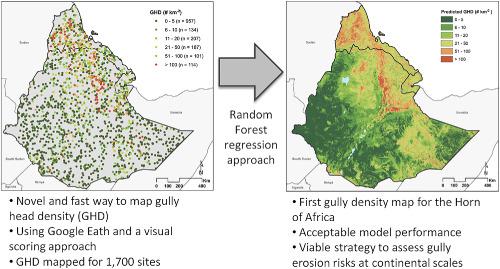当前位置:
X-MOL 学术
›
Earth Surf.Process. Land.
›
论文详情
Our official English website, www.x-mol.net, welcomes your
feedback! (Note: you will need to create a separate account there.)
Predicting gully densities at sub‐continental scales: a case study for the Horn of Africa
Earth Surface Processes and Landforms ( IF 2.8 ) Pub Date : 2020-09-13 , DOI: 10.1002/esp.4999 Matthias Vanmaercke 1 , Yixian Chen 1, 2 , Nigussie Haregeweyn 3 , Sofie De Geeter 1, 4 , Benjamin Campforts 5 , Wouter Heyndrickx 6 , Atsushi Tsunekawa 7 , Jean Poesen 4, 8
Earth Surface Processes and Landforms ( IF 2.8 ) Pub Date : 2020-09-13 , DOI: 10.1002/esp.4999 Matthias Vanmaercke 1 , Yixian Chen 1, 2 , Nigussie Haregeweyn 3 , Sofie De Geeter 1, 4 , Benjamin Campforts 5 , Wouter Heyndrickx 6 , Atsushi Tsunekawa 7 , Jean Poesen 4, 8
Affiliation

|
Despite its environmental and scientific significance, predicting gully erosion remains problematic. This is especially so in strongly contrasting and degraded regions such as the Horn of Africa. Machine learning algorithms such as random forests (RF) offer great potential to deal with the complex, often non‐linear, nature of factors controlling gully erosion. Nonetheless, their applicability at regional to continental scales remains largely untested. Moreover, such algorithms require large amounts of observations for model training and testing. Collecting such data remains an important bottleneck.
中文翻译:

在次大陆尺度上预测沟壑密度:以非洲之角为例
尽管具有环境和科学意义,但预测沟壑侵蚀仍存在问题。在非洲之角等强烈对比和退化的地区尤其如此。诸如随机森林(RF)之类的机器学习算法为处理沟壑侵蚀的复杂因素(通常是非线性因素)提供了巨大的潜力。尽管如此,它们在区域到大陆范围内的适用性在很大程度上尚未得到检验。此外,这样的算法需要大量观察来进行模型训练和测试。收集此类数据仍然是一个重要的瓶颈。
更新日期:2020-09-13
中文翻译:

在次大陆尺度上预测沟壑密度:以非洲之角为例
尽管具有环境和科学意义,但预测沟壑侵蚀仍存在问题。在非洲之角等强烈对比和退化的地区尤其如此。诸如随机森林(RF)之类的机器学习算法为处理沟壑侵蚀的复杂因素(通常是非线性因素)提供了巨大的潜力。尽管如此,它们在区域到大陆范围内的适用性在很大程度上尚未得到检验。此外,这样的算法需要大量观察来进行模型训练和测试。收集此类数据仍然是一个重要的瓶颈。











































 京公网安备 11010802027423号
京公网安备 11010802027423号